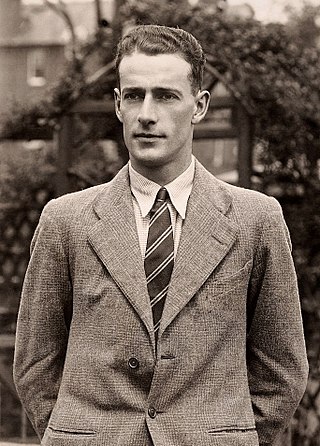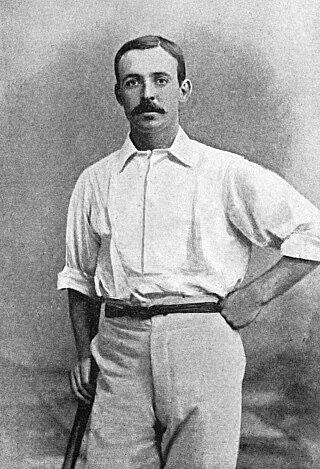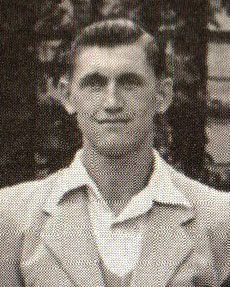Related Research Articles
Timed out is a method of dismissal in the sport of cricket. It occurs when an incoming batter is not ready to play within a given amount of time of the previous batter being either dismissed or retired. This is one case of a 'diamond' or 'platinum' duck, as the player is out without having faced a ball. The first and so far the only batter in international cricket to be dismissed by this method is Angelo Mathews, playing against Bangladesh in the ICC Men's Cricket World Cup 2023. The purpose of the law is to ensure there are no unnecessary delays to the game. It is easily avoided, and it is very unusual for a batter to get out 'timed out'. As of December 2023, there have been no instances of this type of dismissal in Test cricket, a single instance in one day international cricket, and six instances in first-class cricket as a whole. The first batter in Twenty20 International cricket to be dismissed by this method is Godfred Bakiweyem against Sierra Leone in the 2023 Africa Cricket Association Africa T20 Cup.

Alan Melville was a South African cricketer who played in 11 Test matches from 1938 to 1949. He was born in Carnarvon, Northern Cape, South Africa and died at Sabie, Transvaal.

Alfred Edward Street was a cricketer who played for Surrey and later a respected cricket umpire who stood in several Test matches between 1912 and 1926. He was born at Godalming in Surrey in 1869.

George Gerald "Gerry" Tordoff played first-class cricket for Somerset, Cambridge University and the Combined Services in the 1950s and early 1960s.
Edmund Fallowfield Longrigg, usually known as Bunty Longrigg, played cricket for Somerset and Cambridge University. He was captain of Somerset from 1938 to 1946 and later prominent in the county club administration. He was born at Batheaston, Somerset and died at Bath, Somerset.
Archibald Young, known as "Tom", was a professional first-class cricketer who appeared for Somerset in more than 300 matches. Though a regular cricketer for a dozen years, he was frequently in poor health because of damage to his lungs during the First World War and he died at the age of 45, less than three years after his most successful cricket season.

Peter Randall Johnson was a cricketer who played for Cambridge University, Somerset and several amateur sides in a long first-class cricket career that stretched from 1900 to 1927. During his career, he appears to have been known, somewhat formally, as "P. R. Johnson"; modern websites refer to him as "Randall Johnson". Somerset colleague Jack MacBryan, who didn't like him, called him "Peter Johnson".
Alfred John Atfield played first-class cricket in England and South Africa and was also a Test match umpire and an influential cricket coach. He was born at Ightham, Kent, England and died at Caterham, Surrey.
James Geoffrey Lomax played first-class cricket as a right-handed batsman and right-arm fast-medium bowler for Lancashire and Somerset between 1949 and 1962. He was born at Rochdale, then in Lancashire, and died at Frenchay Hospital, near Bristol.
Cecil Charles Cole Case, known as Box Case, played first-class cricket for Somerset as an amateur batsman between 1925 and 1935. He was born at Frome, Somerset and died at Keyford, which is part of Frome.

Arthur Edward Newton was an English cricketer who played for Somerset in the county's pre-first-class days and then for more than 20 years after the team entered the County Championship in 1891. He also played for Oxford University and for a variety of amateur teams. As a cricketer, he was known as "A. E.", not by his forename.
Gary Vincent Palmer played first-class and List A cricket for Somerset County Cricket Club from 1982 to 1989. He also played for the England Young Cricketers side in both under-19 Test and One-day International matches. He was born at Taunton, Somerset and is the son of the former Somerset and England Test cricketer Ken Palmer.
Mervyn Llewellyn Hill was a Welsh first-class cricket wicketkeeper and batsman for Somerset between 1921 and 1932, and also appeared in matches for Glamorgan and Cambridge University. He was also a member of the Marylebone Cricket Club (MCC) team that toured India in 1926–27 and helped lay the foundation for India's entry into Test cricket.
Philip Palmer Hope played first-class cricket for Somerset from 1914 to 1925. He was born at Hartlepool, County Durham, and died at Clifton, Bristol.
Frederic Alexander Waldock played first-class cricket for Oxford University and Somerset between 1919 and 1924, and then for representative sides in his native Sri Lanka between 1927 and 1934. He was born at Colombo, Sri Lanka and died at Galmington, Taunton, Somerset.
Daren Joseph Foster played first-class and List A cricket for Somerset and Glamorgan between 1986 and 1993. He was born in Tottenham, London.
Adrian Nicholas Jones is a former cricketer who played first-class and List A cricket for Sussex and Somerset in the English game from 1981 to 1993 and for Border cricket team in South Africa in 1981/82. He was born at Woking, Surrey and educated at Seaford College in Sussex.
Simon Charles Ecclestone played first-class and List A cricket for Oxford University and Somerset between 1994 and 1998. He also appeared in 1992 in List A cricket for Cambridgeshire. He was born at Great Dunmow, Essex.
Evelyn Vernon Llewellyn Hill played first-class cricket for Somerset from 1926 to 1929. He was born at Cyntwell, Cardiff, Wales and died at Weston-super-Mare, Somerset.
Norman Hardy played first-class cricket for Somerset between 1912 and 1921. He was born at Norton Malreward, Somerset and died at Fishponds, Bristol.
References
- ↑ "The Big Ship". ESPN Cricinfo. Retrieved 23 May 2017.
- ↑ "Death of Mr. H. J. Heygate; An Old Sussex County Cricketer", The Surrey Advertiser and County Times (Guildford, Surrey), July 3, 1937, p.18